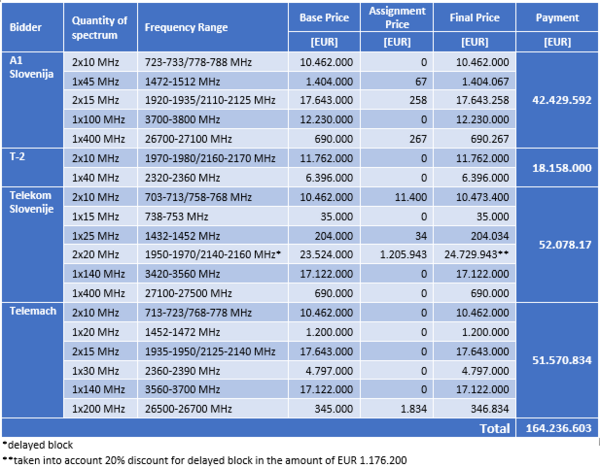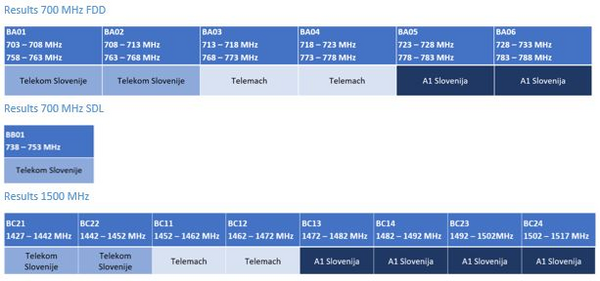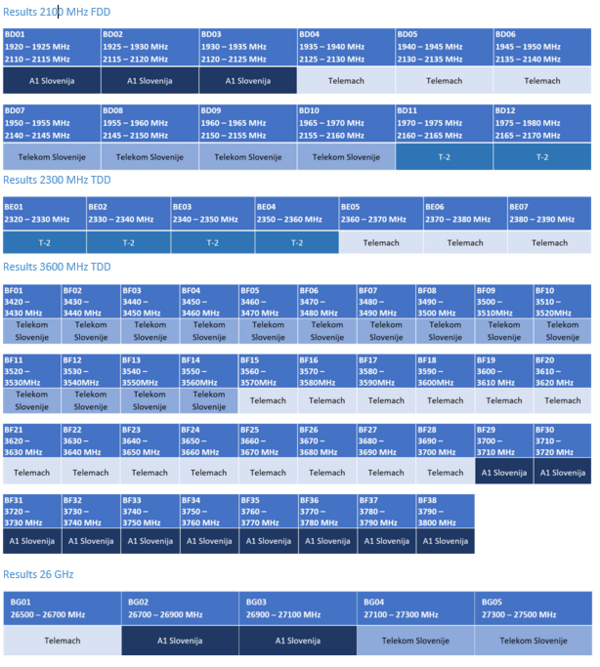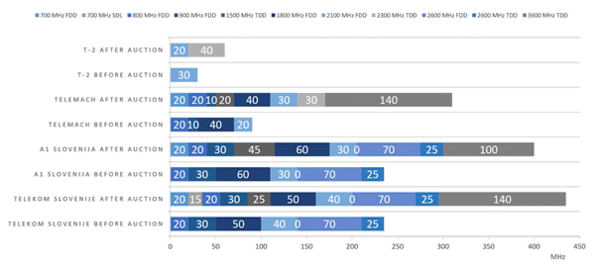Public mobile communications networks are those networks for which terminal devices are available on the open market, and can be used in the system only with a concluded subscriber agreement or an operator's approval. Such systems include 2G (GSM), 3G (UMTS), 4G (LTE), 5G (NR), MMDS, BWA, MWS, and cellular M2M.
These are mobile communications networks that operate in the licensed part of the spectrum, and their use is defined by paragraphs 2 and 3 of Article 33 of the Electronic Communications Act:
- for mobile communications and for providing public communication services to end users (paragraph 3 of Article 33), and
- for mobile communications where the efficient use of a certain radio frequency can only be ensured by limiting the number of issued decisions on awarding radio frequencies (paragraph 2 of Article 33).
Results of Multiband Auction
After 41 rounds of bidding in the main auction, which lasted from 7 April 2021 to 14 April 2021, and 6 rounds of bidding in the allocation phase of the auction, which took place on 16 April 2021, the frequencies were acquired by the following bidders:
- A1 Slovenije d.d.
- T-2 d.o.o.
- Telekom Slovenije d.d.
- Telemach d.o.o.
The table below shows the results by operators:
Radio frequency bands 700 MHz FDD, 700 MHz SDL, 1500 MHz SDL, 3600 MHz and 26 GHz will be available immediately after issuing the licences (expected by the end of the first half of the year). Frequencies in the 2100 MHz band will be available from 22 September 2021 and frequencies in the 2300 MHz band from 1 January 2022 onwards.
All frequency bands shall be designated for terrestrial systems capable of providing wireless broadband electronic communications services and shall be technologically neutral. All frequencies that were awarded will be assigned for 15 years in accordance with Article 53 of ZEKom-1. If the law governing electronic communications that will transpose the provisions of the Directive (EU) 2018/1972 of the European Parliament and of the Council of 11 December 2018 establishing the European Electronic Communications Code (L 321/36 of 17 December 2018); hereinafter EECC) into national law determine this, then the holders of the DARFs will get extension of their DARFs under the provisions of the new law. In the event of an extension of licences, the licence holders will also pay a certain amount for the efficient use of the limited natural resource.
The figures below show the results of the public auction in individual frequency bands:
Coverage obligations
The bidders who acquired the frequency spectrum in any of the radio frequency bands shall be required to offer commercially available wireless broadband terrestrial electronic communications services in each of the acquired radio frequency bands in such a way as to:
- start using these frequencies and offering services to end-users on these frequencies in at least one major city within one year after the availability of an individual radio frequency band,
- within five (5) years after the availability of an individual radio frequency band to use all frequencies in the entire acquired radio frequency band and offer services to end users on all these frequencies in at least every major city.
These time limits do not apply to the frequencies in the 700 MHz SDL, 1500 MHz SDL and 26 GHz bands, which should start being utilized to offer services to end-users on these frequencies in at least one major city within five (5) years from availability.
Operators A1 Slovenija, Telekom Slovenije in Telemach who acquired spectrum in 700 MHz band shall have to provide following scope of coverage by 31. 12. 2025:
- 99% of the population of the Republic of Slovenia
- 99% of motorways and highways,
- at least 60% of main roads and regional roads I and II,
- at least 60% of the active railways with passenger traffic, in-train coverage is under responsibility of railways.
The aim of providing coverage of roads and railways is to offer broadband mobile communications services with a user experience of throughput of at least 10 Mb/s from the base station to the mobile user’s terminal (downlink) and 2 Mbit/s from user’s terminal to base station (uplink) (outdoor) with a RSRP level of -108 dBm.
Operators in 700 MHz FDD and 3600 MHz TDD frequency bands and because of providing comparable services also in the 2100 MHz frequency band, will need to fulfil the following requirements
- within 3 months after DARF is issued, start offering commercial 5G services on at least one frequency band in at least one major city (Table A‑16),
- by 31. 12. 2025 provide commercial 5G services in all major cities. Any applicant who wins in the public tender at least 70 MHz of contiguous spectrum, also has to provide the functionality and support of enhanced mobile broadband access (eMBB) as well as support for massive IoT networks. If these required features are not available, the operator has to provide appropriate evidence. The Agency shall postpone the deadline for compliance on the basis of relevant evidence.
Providing services means that this 5G service is provided through base stations covering at least 75% of the population of an individual settlement of the individual major city, where for the beginning of the use of radio frequencies and start offering services is required that the 5G service is provided through at least one base station in at least one settlement of one major city.
Network sharing conditions
In order to ensure efficient use of the radio spectrum, improve coverage and reduce impact on environment, the Agency shall promote the following sharing options:
- sharing of passive or active infrastructure or spectrum pooling,
- business agreement on national roaming,
- joint deployment of infrastructure for the provision of networks and services based on the use of radio frequency spectrum.
Active sharing and frequency pooling, including dynamic spectrum sharing, is permitted within a framework that does not limit infrastructural competition. For example, sharing of active equipment and frequency pooling are permitted when passive sharing is not sufficient, for example in challenging areas and for network densification. Permission of frequency pooling and active sharing, including dynamic spectrum sharing:
- in challenging areas of the Republic of Slovenia, such as Triglav National Park , Settlements in Triglav National Park and Settlements in other challenging areas, road and railway tunnels, critical road sections, regions of Slovenian border and Piran bay, regions exceeding 60% of active railways with passenger, regions exceeding 60% of main roads and regional roads category I and II, historical monuments and other buildings under protection of Cultural heritage, small cells if there is a restriction on space interventions/building restrictions, and indoor,
- in case network densification needs to secure very high capacity base stations offering Gigabit speeds: road and city infrastructure (e.g., lamp posts, traffic lights …), railway and energy infrastructure, in dense venues (convention centres, concert halls, stadiums, bus and train stations, shopping malls, factories, ports, airports …).
Sharing as defined above is permitted in accordance with competition law principles. For the 26 GHz band, frequency pooling and active sharing, including dynamic spectrum sharing, are permitted everywhere, with a pre-emptive right in favour of the licence holder on its assigned sub-band, and active sharing between all licence holders including dynamic spectrum sharing, is permitted.
However, all sharing allowed in this chapter is allowed provided that the operators comply with all relevant legislation in the field of construction and placement of infrastructure in place, whereby the Agency may adjust the sharing conditions by amending the licences.
In circumstances where market-driven deployment of infrastructure for the provision of networks or services that rely on the use of radio spectrum is subject to insurmountable economic or physical obstacles for operators, and therefore access to networks or services by end-users is not possible, the Agency shall impose on a licence holder who has acquired radio spectrum in this public tender in such an area for the period of licence’s validity obligations related to sharing passive infrastructure or obligations to conclude localised roaming access agreements.
In circumstances where access to and sharing of passive infrastructure alone is not sufficient to resolve this issue, the Agency may impose obligations for sharing active infrastructure.
The objective of this measure is to avoid distortion of competition in areas where other operators have no option of obtaining access to locations commercially on existing network and building a new location is subject to insurmountable economic or physical obstacle.
Security requirements
Operators shall have to establish, perform, maintain and constantly improve appropriate and proportionate organizational and technical measures for managing risks to the security and safety of information systems, networks, services and information.
With the objective of managing security threats and ensuring a high level of availability, authenticity, integrity and confidentiality of the operator’s networks and services, stored, transferred or processed data or related services available over its network, a licence holder shall have to conduct and systematically perform risk analyses with an assessment of the acceptable risk level, and appropriately document this process before implementing any security-related measures.
Results of Public tender for local usage/verticals
The Agency has published the results of the public call for tenders with public auction for the assignment of radio frequencies in the 2300 MHz and 3600 MHz radio frequency bands for local use, the decision on the launch of which was published in the announcement part of the of the Official Gazette of the Republic of Slovenia (Uradni list No 112/23 of 3 November 2023) and its correction in the announcement part of the Official Gazette of the Republic of Slovenia (Uradni list RS No 118/2023 of 24.11.2023).
Successful tenderers will be able to develop local radio networks and advanced wireless services in the 2300 MHz and 3600 MHz frequency bands. This will contribute to improving the quality of mobile communications and encourage innovation in digital technologies.
The Agency intends to offer the remaining unassigned frequencies in municipalities presumably in the second half of 2024.






